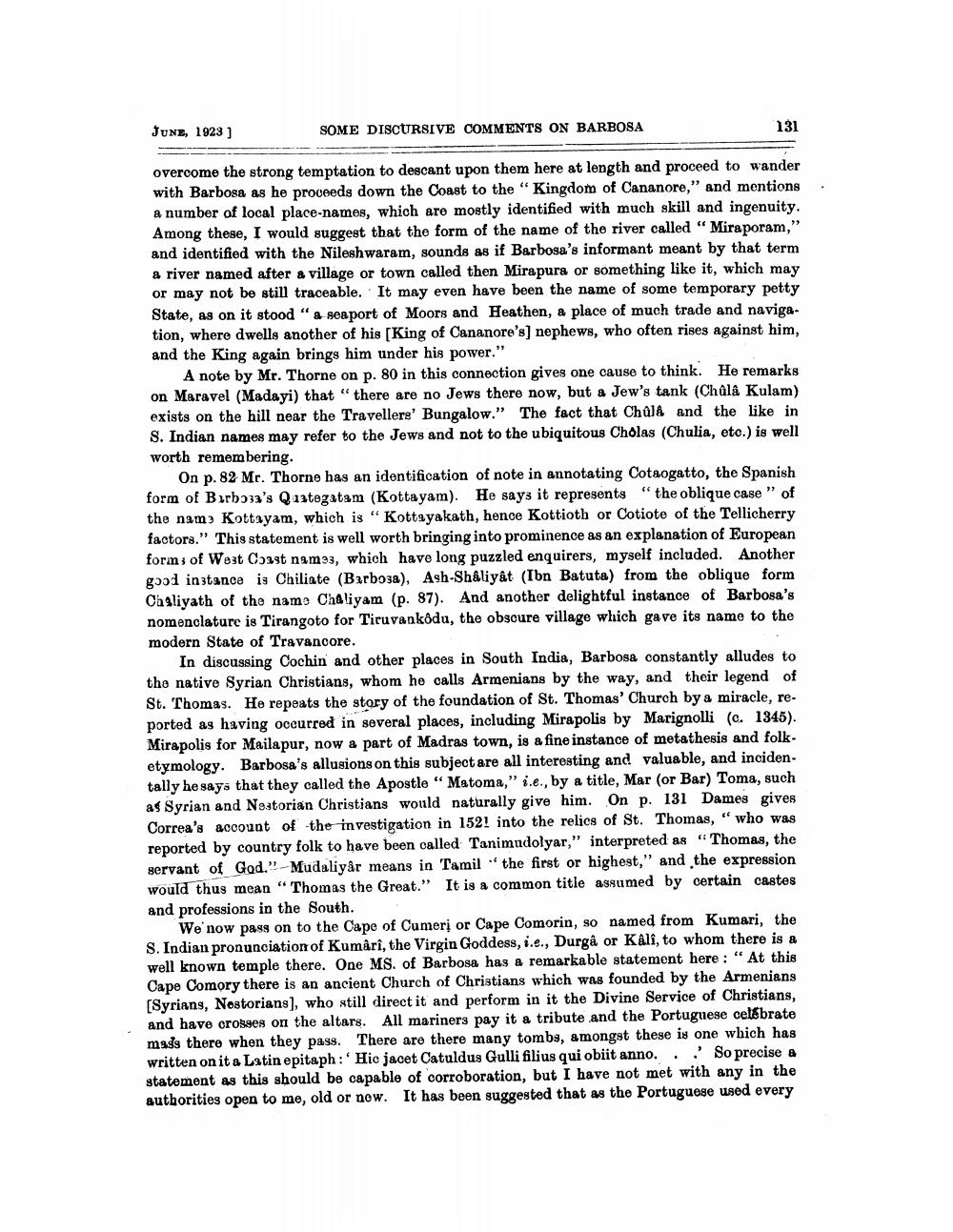________________
JUNE, 1923 ]
SOME DISCURSIVE COMMENTS ON BARBOSA
131
overcome the strong temptation to descant upon them here at length and proceed to wander with Barbosa as he proceeds down the Coast to the “Kingdom of Cananore," and mentions a number of local place-names, which are mostly identified with much skill and ingenuity. Among these, I would suggest that the form of the name of the river called "Miraporam," and identified with the Nileshwaram, sounds as if Barbosa's informant meant by that term & river named after a village or town called then Mirapura or something like it, which may or may not be still traceable. It may even have been the name of some temporary petty State, ag on it stood " & seaport of Moors and Heathen, a place of much trade and navigation, where dwells another of his [King of Cananore's) nephews, who often rises against him, and the King again brings him under his power."
A note by Mr. Thorne on p. 80 in this connection gives one cause to think. He remarks on Maravel (Madayi) that "there are no Jews there now, but a Jew's tank (Châlâ Kulam) exists on the hill near the Travellers' Bungalow." The fact that Chûld and the like in 8. Indian names may refer to the Jews and not to the ubiquitous Cholas (Chulia, etc.) is well worth remembering.
On p. 82 Mr. Thorne has an identification of note in annotating Cotaogatto, the Spanish form of Birbɔza's Quotezatam (Kottayam). He says it represents "the oblique case" of the nam Kottayam, which is "Kottayakath, hence Kottioth or Cotiote of the Tellicherry factors." This statement is well worth bringing into prominence as an explanation of European form of West Coast nam 33, which have long puzzled enquirers, myself included. Another good instance is Chiliate (Barboza), Ash-Shâliyat (Ibn Batuta) from the oblique form Ch gliyath of the name Chaliyam (p. 87). And another delightful instance of Barbosa's nomenclature is Tirangoto for Tiruvankodu, the obscure village which gave its name to the modern State of Travancore.
In discussing Cochin and other places in South India, Barbosa constantly alludes to the native Syrian Christians, whom he calls Armenians by the way, and their legend of St. Thomas. He repeats the story of the foundation of St. Thomas' Church by a miracle, reported as having occurred in several places, including Mirapolis by Marignolli (c. 1345). Mirapolis for Mailapur, now a part of Madras town, is a fine instance of metathesis and folk. etymology. Barbosa's allusions on this subject are all interesting and valuable, and incidentally he says that they called the Apostle "Matoma," i.e., by a title, Mar (or Bar) Toma, such as Syrian and Neatorian Christians would naturally give him. On p. 131 Dames gives Correa's account of the investigation in 152! into the relics of St. Thomas, "who was reported by country folk to have been called Tanimudolyar," interpreted as "Thomas, the servant of God." - Mudaliyår means in Tamil the first or highest," and the expression would thus mean "Thomas the Great." It is a common title assumed by certain castes and professions in the South.
We now pass on to the Cape of Cumerį or Cape Comorin, so named from Kumari, the S. Indian pronunciation of Kumârî, the Virgin Goddess, i.e., Durga or Kali, to whom there is a well known temple there. One MS. of Barbosa has a remarkable statement here: "At this Cape Comory there is an ancient Church of Christians which was founded by the Armenians [Syrians, Nostorians), who still direct it and perform in it the Divine Service of Christians, and have crosses on the altars. All mariners pay it a tribute and the Portuguese cel&brate mass there when they pass. There are there many tombs, amongst these is one which has written on it a Latin epitaph: Hic jacet Catuldus Gulli filius qui obiit anno.. So precise & statement as this should be capable of corroboration, but I have not met with any in the authorities open to me, old or now. It has been suggested that as the Portuguese used every




